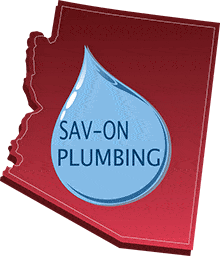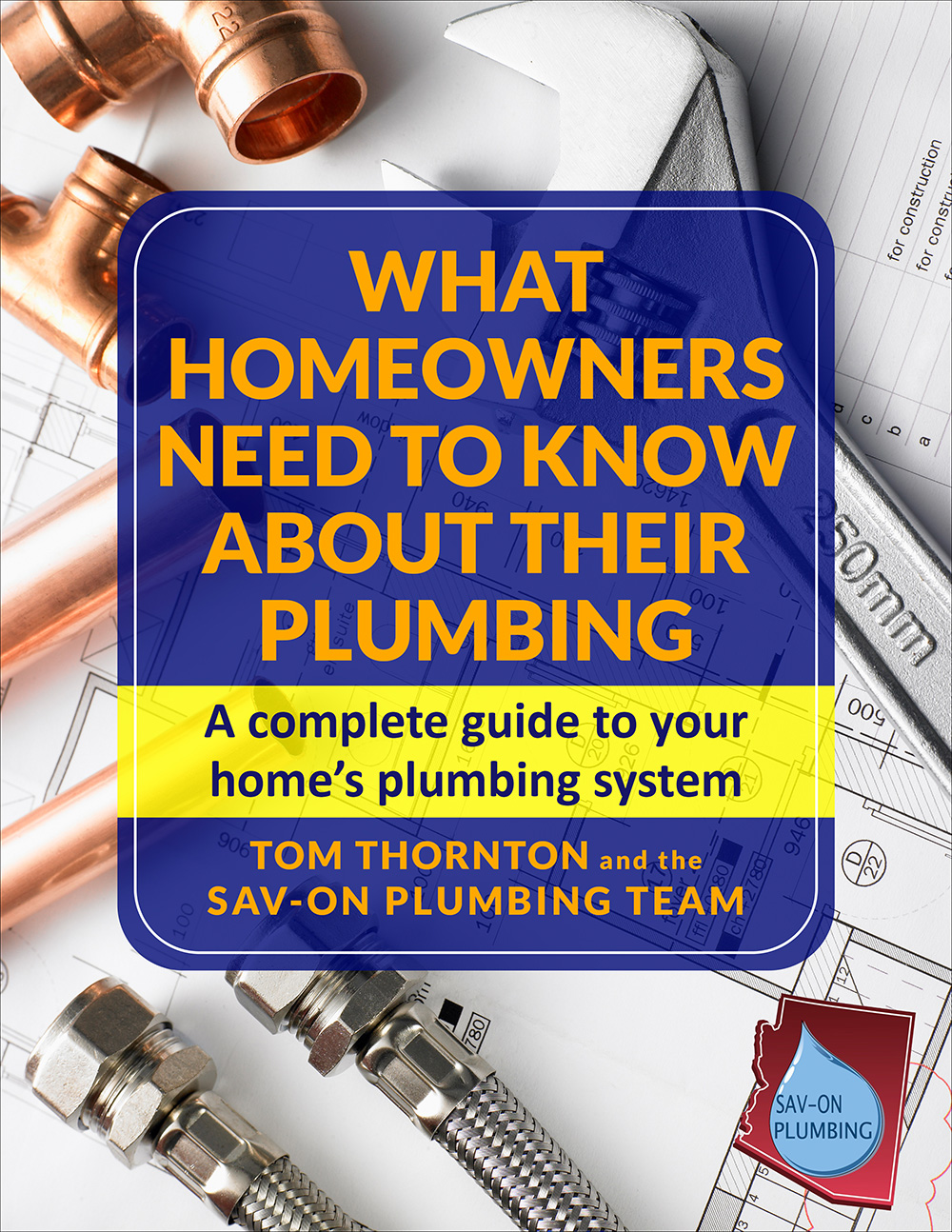
Plumbing is one of the most important systems in your home, and plumbing problems are often scary, surprising, and expensive. We have over 40 years experience in every aspect of plumbing, and we wanted to share all of our knowledge with you in this simple, easy to understand guide.
Think of this as having an uncle who is a journeyman plumber who can answer your questions and guide you through what you need to know about your plumbing.
Thinking of buying a new house? Make sure you read Chapter 2! Even experienced home inspectors might miss a lot of things related to plumbing.
Thinking of hiring a plumber to work on your house, but want to make sure they do good work and you will get a fair price? Chapter 4 is where you’ll want to start, followed by Chapter 11.
Water heater problems? Chapter 5. Drain or toilet clogs? Chapter 6. Other major plumbing issues? Chapters 7-10! You get the picture.
Consider this guide your ultimate resource. Bookmark it so you can come back to it later.
Chapter 1: How Does My Plumbing Work?
Chapter 2: The Real Estate Market is Hot, But Consider the Home’s Plumbing Before You Buy
Chapter 3: Most Important Plumbing Fixtures
Chapter 4: Choosing a Plumber
Chapter 5: Everything You Need to Know About Your Water Heater
Chapter 6: Drain Clogs
Chapter 7: Problems with Drain Lines in Homes
Chapter 8: Problems with Water Lines in Homes
Chapter 9: General Plumbing Problems
Chapter 10: Slab Leaks
Chapter 11: Conclusion: The Importance of Choosing the Right Plumber for the Job
Download the PDF version of this full guide here
Chapter 1: How Does My Plumbing Work?
Your plumbing system is the “guts” of the home, and it’s extremely important to understand how it works and how to keep it in top operating condition.
This is a basic overview of how a home plumbing and water system works.
Water comes in from the street (usually furnished by your municipality) to your water meter by underground water pipe. Water arrives at your shut-off valve, which we’ll discuss in more detail later. When water enters your home, one line goes to your water heater and another line carries cold water to every plumbing fixture in your home. Hot water flows from your water heater to every plumbing fixture that uses hot water.
When you use water in the sink, shower, toilet, or washing machine, for example, excess wastewater goes through drain lines and out through your building drains to the municipal sewer. The building drain lines empty into your sewer lines which empties through your lateral sewer line into the municipality’s sewer system.
A broken pressurized pipe leaking inside your home can cause major damage in just a few minutes. A broken half-inch copper water line with normal water pressure can expel 10,000 gallons of water in just a couple of hours. In mere minutes a leaking reverse osmosis system under your kitchen sink will cause water damage to cabinets and quickly flood your floors.
Chapter 2: The Real Estate Market is Hot, But Consider the Home’s Plumbing Before You Buy
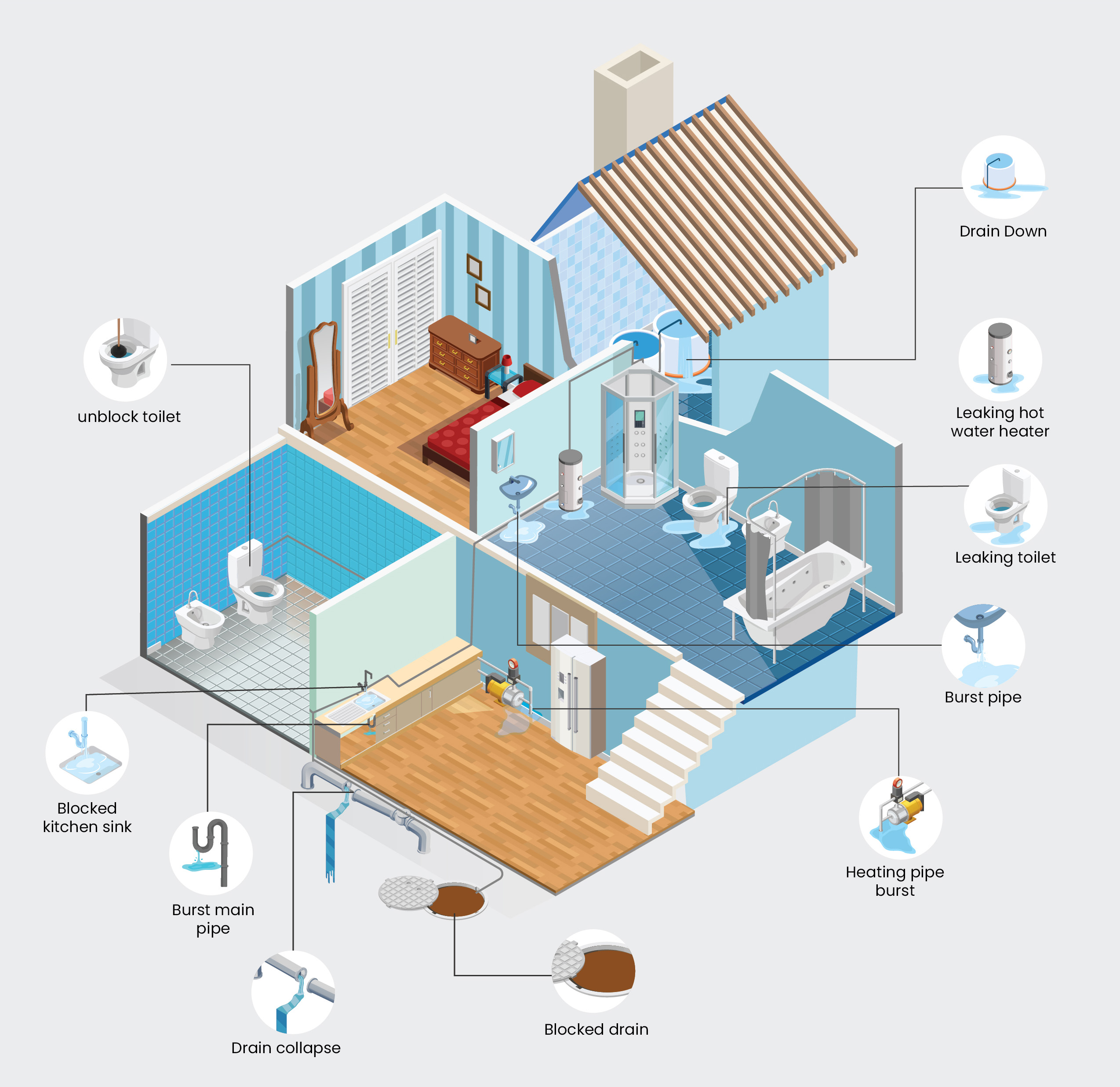
When buying a home, your realtor will suggest a home inspector evaluate the property for any defects before you finalize your purchase. Your realtor may recommend a home inspection firm and we wholeheartedly recommend you pay for this inspection. However, a home inspector is often a generalist, and may know little about plumbing.
He or she will inspect your water heater for general installation issues and may even examine supply lines to determine any problems. However, the best way to protect yourself when buying a home is to also hire a plumbing contractor to complete a whole-home plumbing inspection. After all, plumbing is critical to your home’s functioning. If that dream home has major plumbing problems, you may find yourself spending thousands of dollars for repairs.
With our whole-home plumbing inspection, an experienced plumber will inspect not only the most common plumbing failure points but will also examine more than 60 areas of potential plumbing problems common in your home. This extensive plumbing inspection will both ensure that you know what you’re buying and provide leverage with the seller if there are plumbing problems that the seller should address prior to purchase.
Even in a “hot” real estate market, although the market is rapidly changing with the interest rate increases, many sellers will make concessions when faced with proof their home has plumbing issues.
Here are just a few examples of plumbing components that fail over time or benefit from regular maintenance. An experienced plumbing inspector should comment on all these components.
- Shut-off valves –To prevent damage if a water leak occurs, a shutoff valve must properly function. Frequently, homeowners experience plumbing problems and their water shutoff valve snaps when they attempt to turn off the water. Most gate valves over 15 years old are very prone to breaking. We’ll discuss shut-off valves later.
- Galvanized pipe – Used for decades prior to the 1970s, galvanized pipes tend to build up scale on the pipe’s interior, clogging your pipes or fouling your drinking water. As they age, galvanized pipes deteriorate and can cause a health hazard and potential flooding hazards over time.
- Water heater – Your water heater is one of the most likely plumbing components to fail unnecessarily, often due to neglected maintenance. Many homeowners do not know their water heater requires yearly maintenance. A water heater that receives regularly scheduled maintenance will typically last twice as long as a poorly maintained water heater.
- Toilets – Toilets also have problems that can arise over time. It may take two tries for a complete flush or your toilet may leak in different spots. A good plumber can advise you if your toilet needs replacing or if it just needs an adjustment. A leaky toilet can waste over 6,000 gallons of water per month.
- Water softeners and water filtration systems – These items present a number of potential issues. This includes leaking, sudden failure, tank ruptures, media filter (filters that remove unwanted particles from water) failures that clog water pipes, and a host of other problems. Even a tiny crack can cause a major flood since these are pressurized systems.
- Water lines and sewer lines – Especially on older homes, every home inspection should include a camera inspection of your sewer line. The inspection should also include the composition of your water lines and their life expectancy. Costs to repair sewer and water lines can easily run into the thousands of dollars, so your pre-purchase diligence can return big dividends.
In a hot housing market, many buyers succumb to market pressures and often make quick decisions. You can quickly schedule a whole-home plumbing inspection to ensure that the plumbing is in good working condition before you close escrow.
Make Sure You Ask the Right Questions During Your Home Inspection. Download Our Free Checklist Here
Is that home you’re considering a “flip” or a former rental property?
In the current real estate market, many long-time homeowners are cashing in their equity and selling to investors. These investors quickly remodel the home and “flip” it, often netting tens of thousands of dollars in profits. A flip home may seem attractive because the seller/flipper may have done a cosmetically pleasing job on the remodel. However, the workmanship may be shoddy and problems with the home often arise soon after moving in.
Take a local home near us as an example. We knew the owner, who had struggled financially for years, delaying maintenance, landscaping, and needed repairs. Finally, as the home values in our area surged, he sold the home to an investor. The investor drove up in his Corvette and within days, laborers began to arrive to gut the home. We watched a complete remodel, including a new roof, take place over the next few months. But guess what? At no time did one truck with a contractor’s name on it appear. Every laborer came in a personal vehicle or truck. Who was performing the work? Probably not licensed, bonded, and insured contractors. Nor did we observe the city inspectors arrive at any time for an inspection.
The home stayed on the market after the remodel for only a few weeks. The new owners were Millennials, thrilled to be in their first home together. A few days after they moved in, a plumbing truck arrived, followed by a major rainstorm that night. A roofer showed up to patch the roof. The home had problems and the homeowners hadn’t been in the home for two weeks.
Is this true of every flip? Maybe not. But here are a few things to consider if you are in the real estate market.
Is the home a recent “flip”?
According to realtor Jeff Taber, who works with many Glendale homeowners at Help-U-Sell West Valley, you may want to visit the county recorder’s office. “Check who the owner is, how much they paid, and how long they held the house. If the current seller holds it for only three-to-six months, it’s a flip. If the home’s interior is all new and painted, that’s a tell-tale sign. If the kitchens and baths are redone, it’s probably a flip,” Taber said.
You can avoid flipped home headaches
Taber offers a few tips for avoiding flipped home headaches. “Get a home inspection from a reputable inspector. Also, get a professional plumber and a qualified air conditioning person to inspect the home. Home inspectors simply don’t catch everything. You’ll pay a bit more for these inspections, but they are worth every cent if you avoid even one broken drain or a major air conditioner defect.
“Be sure to get a home warranty,” Taber recommends. “You can ask the seller to pay, but if the seller won’t, invest the $450 or so to buy the home warranty yourself. The first year is the cheapest; each year the premium goes up slightly,” Taber explained.
Obtain a disclosure form
“Ask the current owner for a full list of all completed repairs and renovations. You want details, if possible – who did the repairs and what was done – and ensure the owner signs it,” Taber recommends. “Also ask for any permits obtained by the flipper. You may find nothing was inspected, which can mean things like a water heater probably wasn’t installed to current code and more,” Taber said.
“Most flippers won’t fill out the [disclosure] form. They’ll say, ‘I don’t know what’s wrong; I just bought the house.’ This is usually not true because they’ve just gutted or opened the house, and they know what they fixed. If they tore the wall apart and they see evidence of a water leak, they know what’s going on. They do not want to commit to the disclosure form because, without a signed disclosure, it makes it harder to sue them.” In a hot real estate market like the current Phoenix market, flippers commonly refuse the disclosure, according to Taber.
“Don’t focus only on the looks of the house; focus on the quality,” Taber said. “You can always make changes gradually after you take possession. That is preferable to buying a cosmetically pleasing house riddled with high-cost fixes.”
“Some who flip homes are good flippers,” Taber said, “But others aren’t. Sometimes problems show up quickly and sometimes problems show up much later. Either way, they can still be costly,” Taber said.
Here are some of the plumbing problems we’ve seen in home purchases
- Sink pipes corroded to the point that within weeks of purchase the sink backed up and the kitchen sink pipe shattered.
- Water heaters not installed to code, which can be a major safety issue.
- New kitchen and bath plumbing tied into old, corroded pipes.
- Non-brand name plumbing fixtures that, once they require repairs, will be difficult to part source.
- Irrigation system connected to the main service line (missing a pressure vacuum breaker), which is a code violation. This presents a potential health hazard.
- Missing hose bib vacuum breakers, a potential health hazard and a code violation.
All this is not to say that every real estate “flip” is a bad home or a pile of problems waiting to happen. It just means that due diligence is critical to avoid a home’s problems becoming your problems.
Chapter 3: Most Important Plumbing Fixtures
Let’s explore some important home plumbing information.
Why is it important to know how your plumbing works?
Even if you aren’t the “handy” type, it’s important to have a basic understanding of how home plumbing works. With this understanding, you’ll be able to
- Complete simple repairs and know what you can and can’t do yourself
- Know what to do if there is an emergency, avoiding significant water damage and additional problems
- Avoid unscrupulous repair people who target those who don’t know much about their plumbing (we’ll talk more about this later).
The most important plumbing fixture in your home
As much as we love hot showers and clean clothes, the most important piece of plumbing in your home is not the water heater or the washing machine. The most important piece of plumbing in your home is not in your home at all. It’s also usually the most overlooked because you never use it until you need it.
After years of experience in plumbing gone wrong, our vote for the most important piece of plumbing goes to the water shut-off valve, located outside your home where the water enters the home.
Why is this the most important piece of plumbing? The water shut-off valve controls all the water that enters your home. It is your primary defense against a flood in your home and a water damage claim. If your water heater suffers a catastrophic leak, for example, and the shut-off valve on the water heater malfunctions, your main shut-off valve prevents a flood.
If there is a shower or bathtub that won’t shut off, your main shut-off is your only option because shower and tub/shower valves do not have their own individual shut offs. Faucets, sinks and toilets have individual shut offs, but unless they have been turned off and on occasionally, they too have a high failure rate. There’s nothing worse than trying to shut off a toilet or sink valve only to have the angle stop valve handle break off in your hand.
The best thing a homeowner can do is to periodically test the main shut-off valve. Turn it off and see if that completely stops all the water from coming into the house. You can tell it’s working by turning on your hose after you shut off the valve. Nothing should come out. Then turn your valve back on and see if this restores full water flow to your home. If that’s not the case, it’s time to call for professional help.
We recommend a ball valve shut off over a gate valve. A ball valve has a lever handle, and a gate valve has a round handle. As gate valves age, they often won’t shut off or won’t turn back on once shut off.
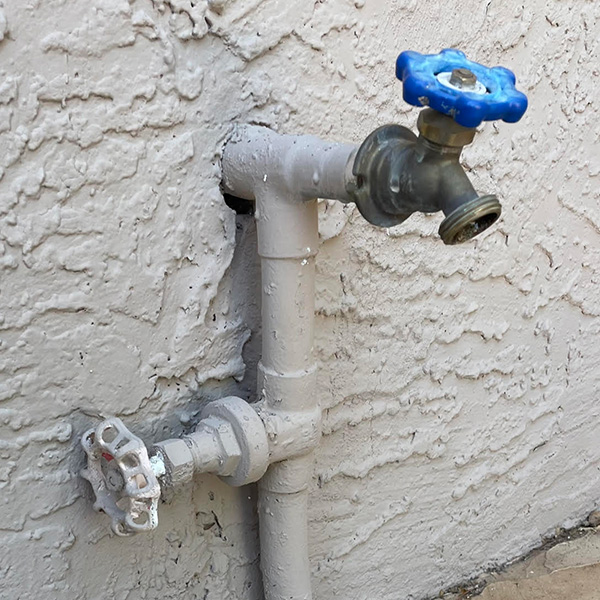
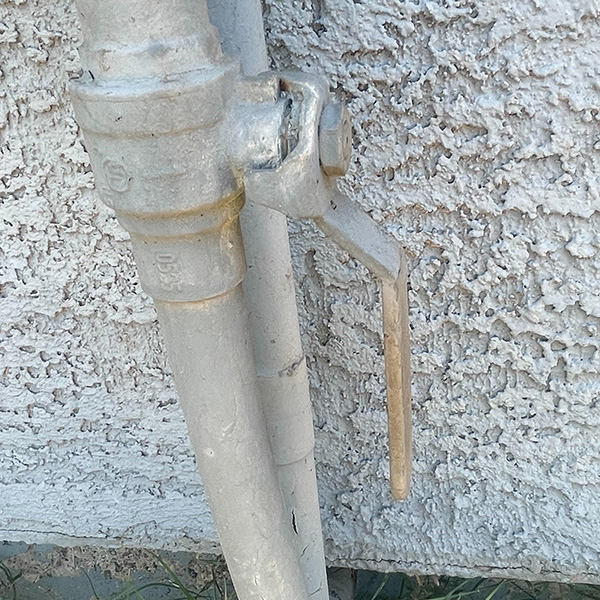
Chapter 4: Choosing a Plumber
From your bathroom to your laundry room to your kitchen, you rely on your home plumbing system. But when a plumbing problem arises, the first consideration is usually, “How am I going to afford this repair?”
It’s true that plumbing services can be quite costly. Price depends on the job, and any plumber who provides a quote over the phone, without examining your problem, is not doing you a favor. There are many variables in plumbing jobs, and only by reviewing the problem and considering the time and parts costs can a plumber provide an accurate quote.
When faced with plumbing costs, it’s tempting to seek out a plumber based primarily on price. However, we advise you to resist that temptation. Choosing a plumber based solely on price involves some major risks that can cost more in the long run.
Another problem can arise if you insist on demanding a plumbing contractor to provide a quote over the phone. Even if you’re sure you know what the problem is, “My toilet needs a rebuild,” the plumber takes time to evaluate the problem to determine the root cause. Reputable plumbers rarely provide a quote without evaluating first evaluating your problem. No one wants to receive a low-ball plumbing quote on the phone, begin the repair, then learn, “Hey, it’s a bigger problem than we initially thought.”
To find a trustworthy plumber, limit your search to licensed, bonded and insured plumbers with excellent online reviews. Look for the words “bonded and insured” whenever hiring any type of contractor. If you decide to go with a handyman, many are not registered contractors. If a problem arises with the work, there is often no recourse but small claims court. Whether they call themselves a contractor or handyperson, in the State of Arizona, any person or company who performs work over $1,000 including labor and materials, or that requires permitting, must be a licensed contractor.
If problems arise with a licensed contractor, you can file a complaint with the Registrar of Contractors (ROC) in your state. The ROC then works with you and the contractor to resolve the problem.
Also ensure the contractor’s license covers the type of work they will perform. For example, you don’t want to hire a handyman to install a roof. A contractor working outside his or her licensed class can also impact the contractor’s insurance coverage should you have to file an insurance claim against the contractor. Checking the license status and type of license can prevent hiring someone who is working outside his or her licensing authority.
Before deciding which plumber to hire, ask which company underwrites their insurance, and ask them to provide a certificate of insurance. A trustworthy plumber will willingly provide proof of insurance coverage. The plumber’s insurance agent can provide a certificate, or the plumber may keep one on file. We also recommend calling the agent listed on the certificate of coverage to ensure that the insurance coverage is still in force and has not lapsed.
Keep the insurance information in case you must file a claim under the insurance
Why is it essential for plumbers to carry insurance?
There are many different types of insurance that you’re probably familiar with, and they all provide some kind of protection. Health insurance pays for medical treatment, and auto insurance helps cover damages from car accidents. In the plumbing world, what you’re looking for is general liability insurance, which protects both the contractor and the customer in the event of an unforeseen accident. As an additional layer of protection, many contractors also carry worker’s compensation insurance. In fact, even with only one employee, many states’ laws require the contractor to purchase workers’ compensation coverage which is the case in the State of Arizona.
Believe it or not, if an uninsured worker gets hurt while on your property, the worker can sue you if the employer refuses to or cannot pay for the worker’s injuries. This is a crucial reason you should always do business with a company that carries adequate insurance.
Liability insurance can also protect your home if anything goes wrong with the job. Examples could include a plumber setting fire to the attic after using a torch or dropping a heavy drain cleaner on your tile floor, cracking it.
The lowest price may cost more
We know it’s tempting to shop around for a lower price – everyone wants a good deal. Getting work done on your home is expensive. However, it’s worth the extra money to find a well-reviewed, trustworthy plumber with the right experience, licensing and insurance coverages. Hopefully, everything will go smoothly, but if it doesn’t, using a properly licensed and insured professional can protect you.
More thoughts on pricing
A plumber needs to stay in business to honor his or her warranties. Unlike many plumbing companies, we offer a six-year parts and labor guarantee on any water heater we install. If you call five years after installation, you will want us to answer the phone.
Plumbers, like any contractor, must set prices to make payroll, pay for insurance and licensing requirements, buy fuel and maintain their trucks, pay for supplies, and pay their employees. Plumbers work hard and, like any contractor, deserve to make a profit. We don’t personally know any wealthy plumbing contractors among the smaller contractors we work with. “Beating up” a plumber over price means someone else has to pay a higher price to compensate, or the plumber takes a loss over time and eventually his or her business folds.
How to avoid getting scammed
Women and the elderly are particularly vulnerable to shady contractors. Anyone, however, can fall prey to a dishonest contractor. Here are some tips to avoid being taken advantage of.
- Ask the company if their plumbers are background checked and drug tested. Our plumbers have a “Trusted Plumber” designation offered by Plumbers Success International, verifying that we background check and drug test prior to hire.
- Avoid unlicensed contractors.
- Check the business’s reputation with the Better Business Bureau.
- Check with your state’s Registrar of Contractors to determine the contractor is licensed and if the contractor had complaints.
- Avoid using a handyman on most plumbing jobs.
- Know that immediately after disasters, unscrupulous contractors will arrive from other states in droves, often taking advantage of unwary homeowners. While this doesn’t much affect plumbing in Arizona because our weather is so temperate, it does impact roofing and some other trades.
- On bigger jobs, the contractor may ask for a down payment. This is normal. However, if you provide a down payment then the contractor asks for more money without completing at least part of the work, beware.
- Read the company’s online reviews. Check how they handle online complaints because every plumber will occasionally get a complaint. Do they respond in a professional manner?
- Request estimates in writing. The estimate should include details of the work and estimated costs. On larger jobs, you’ll want a completion date, as well.
The American Association of Retired Persons (AARP) offers some great tips on working with contractors to avoid getting scammed.
In over forty years serving the Phoenix metropolitan area, we’ve seen some unfortunate plumbing scams. Here are a few.
- A plumber charged an elderly person over $40,000 to replace a sewer line. (That one made the news.)
- A plumber installed cleanouts but failed to connect the cleanouts to the sewer line.
- A plumber contracted to install new drains under a mobile home, but the contractor simply washed off the pipes so that they looked new.
- A plumber told a Sun City resident he needed a new water line for $6,500. The homeowner called us for a second opinion. He did not need a new water line. We repaired a float in his water feature and fixed the problem for under $300.
When dealing with any contractor, that old adage, “Trust your gut” is a good one. If the “deal” seems too good to be true, the price too high, or you feel uncomfortable with the plumber, get a second opinion.
One final thought – You may hear plumbers referred to as “mechanical contractors.” Mechanical contractors provide service and repair for pipe-based systems both in and outside your home. This includes your plumbing vents.
Chapter 5: Everything You Need to Know About Your Water Heater
Water heaters have an effective lifespan of about 10 to 15 years. If you start to notice trouble with your water heater, the question is usually whether to repair or replace.
Different types of water heaters
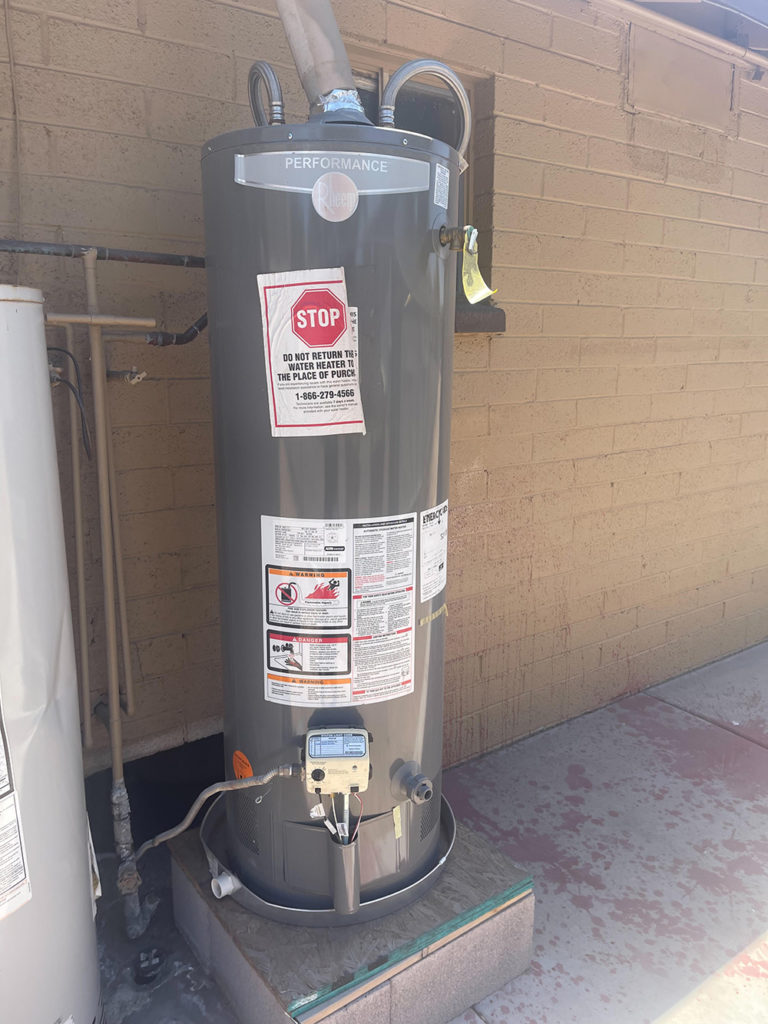
Traditional tank water heaters – Your water heater produces hot water then pushes it through your pipes, so it arrives where needed, whether to the dishwasher, the shower, faucets, or your washing machine. Whether gas or electric, the tank water heater is the standard water heater found in most homes. Water heater capacity varies from 20 gallons to 120 gallons. For a home with only one or two occupants, a 30-gallon gas water heater may be sufficient. Households with three to five or more occupants will need a minimum 40-gallon gas or 50-gallon electric water heater. Gas heats water more quickly and efficiently than electric but costs a bit more upfront.
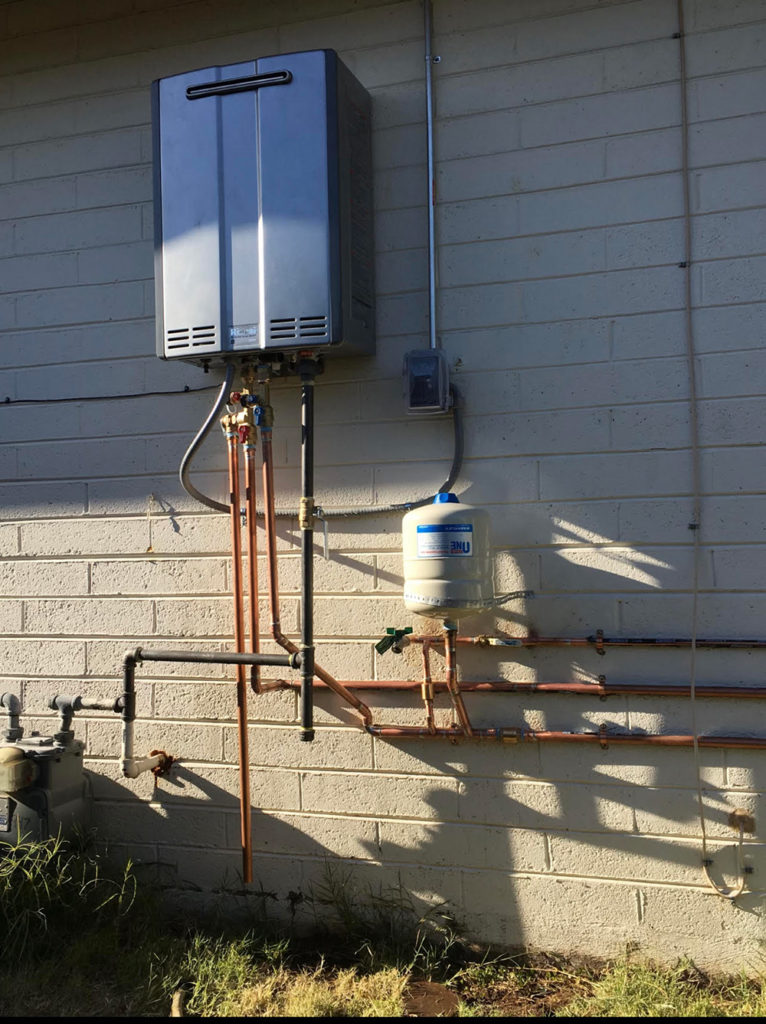
Tankless water heaters – More people today choose tankless water heaters. Gas tankless water heaters supply endless hot water and are more energy efficient than a tank water heater. Tankless units typically cost significantly more than traditional tank water heaters, about double the cost. Their life expectancy is about 15-to-20 years, versus from 6-to-12 years for a traditional tank water heater.
Tankless water heaters are also more energy efficient because they produce hot water on demand.
If replacing your water heater, the investment in tankless, which can be more than double the cost of a traditional water heater, may be worth the extra cost. No matter what type you choose, proper maintenance is the key to extending the water heater’s life. We do not recommend installing electric tankless water heaters because the technology is not as well developed yet.
Some musts for a safe water heater installation
When searching for a water heater, ask about the warranty. Most water heaters come with a six-year parts warranty and a one-year labor warranty by the installer. All our water heaters come with a six-year parts and labor warranty if something goes wrong.
Next, the installation should include two shut-off valves, one on the hot-water line and one on the cold-water line. In the event of a tank rupture, you’ll want to be able to shut off the water heater without shutting off your main water supply.
Next, all water heaters should have a water heater drain pan.. The plumber installs the drain pan under the water heater to catch water from any leaks or spills and to catch any condensation. When possible, the plumber will route the drain pan to the exterior of your home so that water escapes outside rather than flooding your home. If the location does not allow for the routing to your home’s exterior, we install a fitting with a cap so you can attach a hose to drain it if the water heater begins to leak.
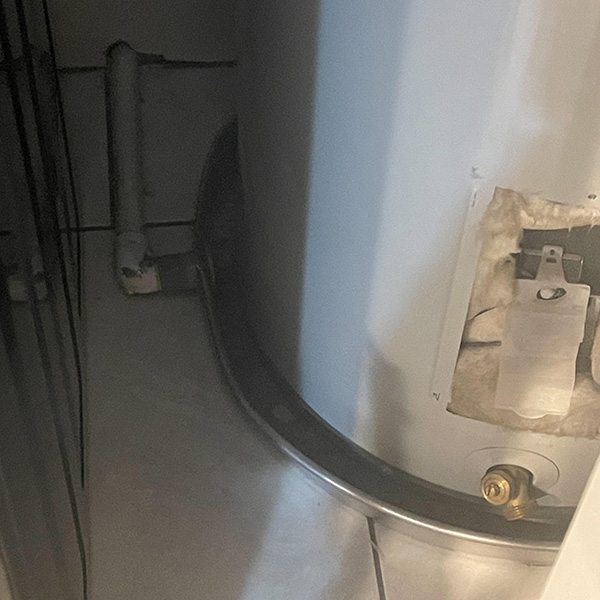
Additionally, a water heater should have a full-port drain valve. Manufacturers recommend draining a water heater annually for maintenance. The full-port drain valve has a larger opening than a standard water heater drain and allows the draining of sediment that may collect in your water heater.
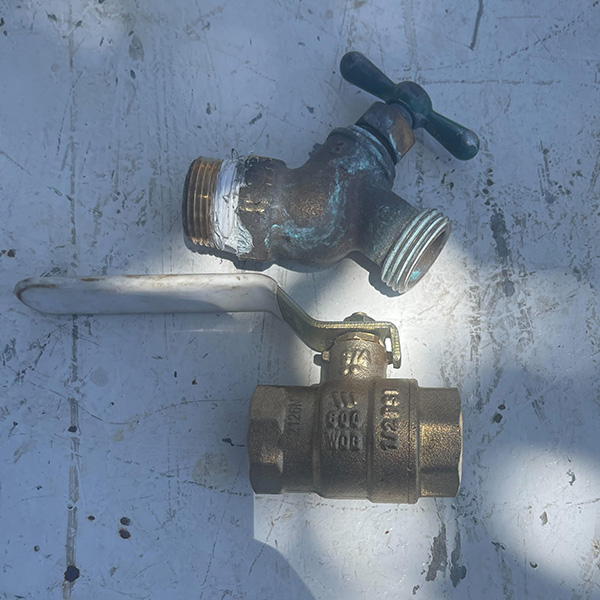
Bottom – full-port drain valve
Water heater maintenance musts
A plumber (or you if you’re handy) should flush your water heater annually. The anode rod, which keeps harmful minerals in your water from attacking and corroding your tank, requires inspection every three years, and if needed, a replacement. Failure to maintain and replace your anode rod when needed will cause your water heater to fail prematurely.
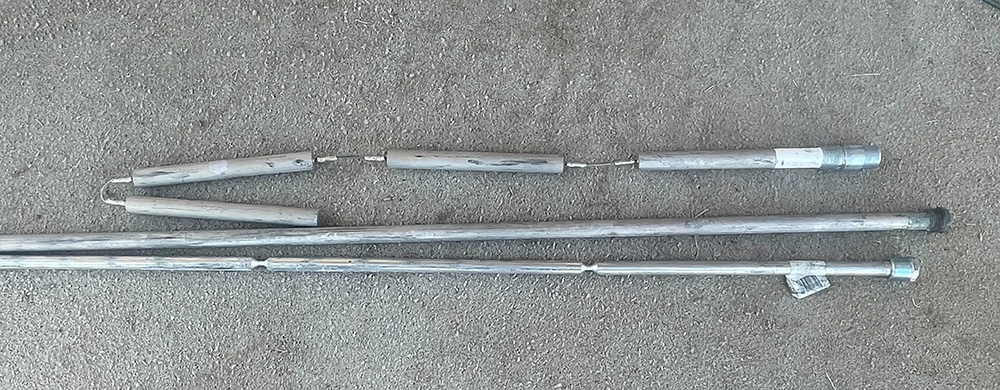
You’ll want to perform an annual inspection of your temperature and pressure relief valve, opening and shutting it off. Since excessive water pressure is the number one enemy of water heaters, it’s important to know your home’s water pressure. A plumber can test your home’s water pressure with a test gauge.
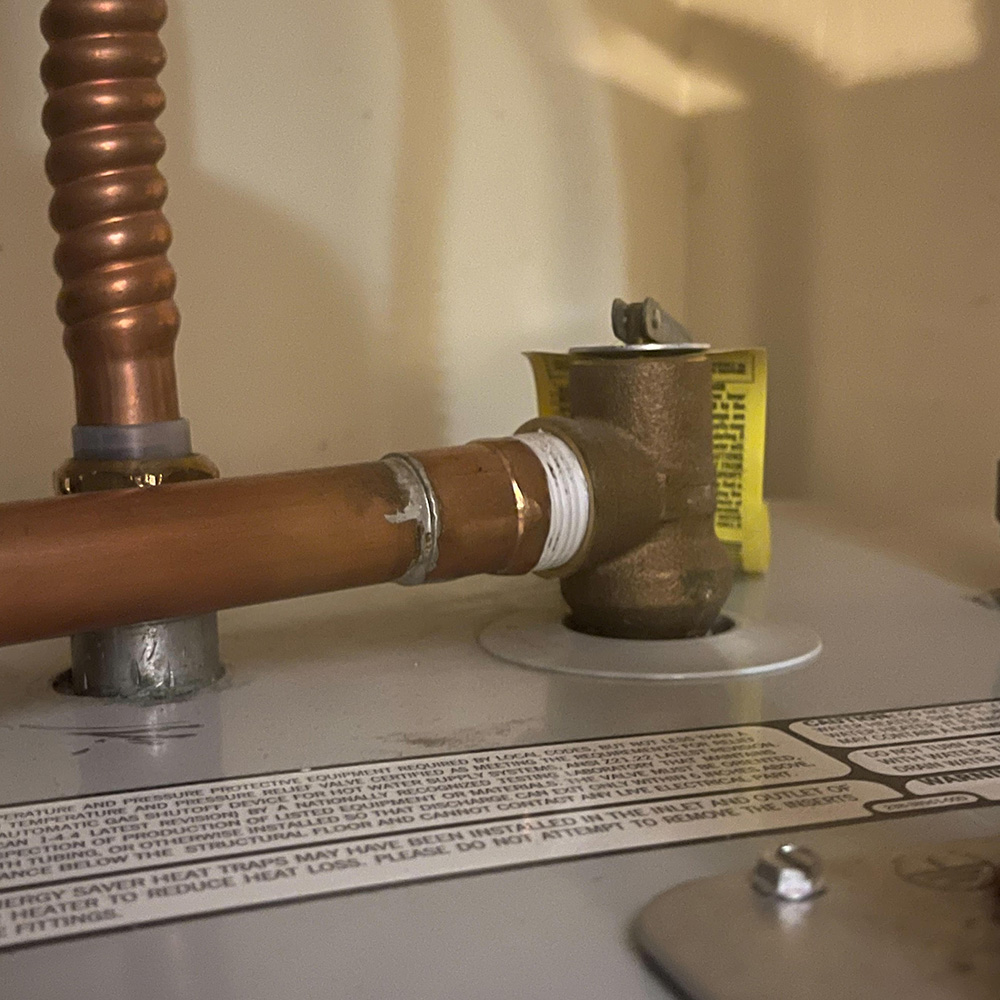
In Arizona, plumbing code requires a water pressure regulator if your home’s water pressure exceeds 80 pounds per square inch. Requirements may vary by state.
The water heater isn’t working. Now what?
Before calling a plumber for water heater repair services, check your electric panel and make sure the water heater’s breaker didn’t trip. (This is also a good idea any time one of your household appliances stops working.) We sometimes get calls for problems that turn out to be a simple flip of the switch.
Manufacturers engineer water heaters to last up to 20 years with proper maintenance. By following the water heater’s recommended maintenance plan, it can last a long while. Without regular care, your water heater may not last more than seven years. Additionally, an improperly maintained water heater often fails near the bottom of the tank, flooding your home and causing you to file an insurance claim.
How to tell when it’s time to replace your water heater
There are a few signs it might be time to replace your water heater. These signs include:
- Running out of hot water
- Rust forming on the outside of the hot water tank
- Odd smells or colors coming from your water
- Water that isn’t hot anymore
- A noticeable increase in your water or electric bill
- Water leaking from the water heater or pipes connected to it
- Strange noises coming from the water heater as it struggles to heat water
- A water heater that is older than seven years and has not been properly maintained
Why you don’t want to buy a water heater at a big box store
We receive several calls each week from potential customers who purchased their water heaters at big box stores. Here’s the problem with that. First, the water heaters sold at big box stores are not the same quality as those sold at plumbing supply stores. Professional-grade water heaters have higher manufacturing standards.
When buying a water heater from a reputable plumber, they’ll not only provide a warranty if they furnish the water heater, but the appliance will also be of much higher quality because it’s a professional grade water heater. It’s made with more steel and a thicker tank. It will also have a brass drain valve versus a plastic one, which is much more likely to break. A professional grade water heater is ceramic lined. Your big box water heater will have lower grade elements and the tank won’t be as substantial. With a professional grade unit, you’ll have a water heater with a longer average life span.
Every water heater will eventually need service, and you want a water heater where parts are readily available, not a two-or-three day or more wait, or longer.
When buying from a big box store, you’ll have to call a customer service line, wait on hold for a long while, only to be told to call a plumber if the water heater is still warrantied. Water heater not working on a Sunday or holiday? With a big box store, it may be the next business day before you reach customer service.
With a big box water heater, you call a plumber, who will tell you to call the manufacturer back and have them diagnose the problem. If you wait until the plumber arrives, you’ll still have to call them back to order parts and pay the plumber for the time they spend while you wait on hold.
When the ordered parts arrive, it may fix the problem, but sometimes the parts are not correct. If the parts the manufacturer provides are faulty or the wrong parts, you’ll hate the wait for replacement parts. The result is a long, frustrating loop and possibly waiting for hot water for a week or much longer.
Further the warranty on big box water heaters is only one year in home. After that, you’ll have to pay for the labor and if you don’t ask for a diagnosis when you call, the plumber will charge you for the diagnosis.
When a water heater fails, this typically means a loss of more than 40 or 50 gallons of water from the system. Additionally, water heater supply lines are pressurized, and once your tank fails, water continues to flood your home until you either shut off the water heater’s shut-off valve (if it has one) or your main water supply.
When buying from a plumber, plumbers usually carry the needed repair parts on their truck, saving time and a great deal of frustration.
One of our frequent calls occurs when a homeowner’s big box water heater fails. They usually regret their decision to install these less than stellar water heaters.
For more facts about big box water heaters, visit this Minneapolis plumber’s read, a great overview of the challenges associated with non-commercial grade water heaters.
Why does my water heater require a pressure relief valve?
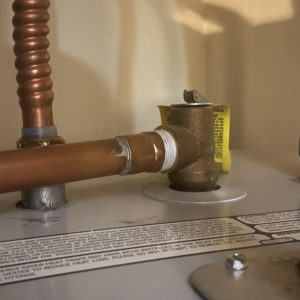
By Uniform Plumbing Code (UPC), every water heater must have a temperature/pressure relief valve. Manufacturers design the valve to function only under two circumstances.
- If the water temperature exceeds 160 degrees Fahrenheit.
- If the water pressure in the tank exceeds 150 pounds per square inch (PSI).
You or your plumber should open, close and inspect your pressure relief valve annually. Your valve must have a gravity drain to a safe point of discharge, usually outside the home.
These safety measures help to avoid flooding in your home or a catastrophic water heater failure.
Owner-supplied plumbing parts often ultimately cost more than plumber-supplied parts
We have all become comfortable shopping online and purchasing plumbing parts and fixtures are no exception. We all want to save money but buying online can end up costing more.
Homeowners can now, with a few clicks, purchase plumbing fixtures, faucets, toilets, shower heads, even water heaters online. During the recent shutdown, many homeowners upgraded their homes, and to avoid stores, purchased plumbing parts and fixtures online. This created a few problems for them.
Very often, packages arrive from overseas with parts missing or misaligned. When the happy homeowner opens the box, however, he or she only sees a faucet or a showerhead. The homeowner calls the plumber, who warns that while they will install the customer-supplied parts, they do not warranty the part. Often the plumber cannot install the part due to missing, damaged, or defective parts. In fact, some plumbers will not install customer-supplied parts, so a homeowner may resort to hiring a handyperson, who may or may not have much plumbing expertise.
Additionally, although part names online may sound the same, the quality of the online purchase may be sorely lacking. Fittings may not be chrome or brass; they may be rubber, and gaskets may be thinner.
Overall, it pays to avoid buying any plumbing fixtures online. Contractors only warranty the parts they sell, not the parts you furnish. Additionally, many of our customers have tried to return defective parts only to be told “no returns.” You’ve spent money on a part, paid the plumber’s labor, then had to purchase the correct or non-defective part. This ends up costing much more than originally budgeted.
We all want to save money. Scrimping on plumbing parts by purchasing them online is not a good way to save money on plumbing.
Chapter 6: Drain Clogs
Problem 1: Garbage disposals
Garbage disposals are a modern kitchen convenience. Who doesn’t like the idea of getting rid of a smelly bucket of garbage in their home? Garbage disposal replacement is not only expensive, but also a major inconvenience in time, money and mess. Here are some dos and don’ts to get the maximum life out of a garbage disposal:
Do
- Make sure the garbage disposal drain has a downward slope. If it doesn’t, water and waste accumulate in the disposal, causing internal components to rust out.
- Use lots of cool water when running the disposal. Hot water can turn some waste into mush, making it harder to break down.
- Turn on the water before beginning to feed waste into the disposal.
- Keep the water running for a few seconds after the disposal stops grinding. This flushes the unit completely and helps eliminate clogs farther down the drain piping.
- Keep the disposal clean and smelling fresh by feeding it citrus peels. Grinding up ice also works if citrus is not available.
- Always take the time to read and follow the directions in the owner’s manual on the care and use of your disposal. There may be instructions specific to the disposal.
Don’t
- Don’t put grease, oil, or fat down your disposal. Grease collects inside the disposal and the drainpipes, causing problems, often at the most inconvenient times.
- Don’t put expandable food waste like rice or pasta into the disposal. Once you add water, expandable food products swell, causing blockage problems.
- Don’t put stringy or fibrous waste into the disposal. These are items such as potato peels, corn husks, onion skins, or carrot peels. Dispose of these items in your garbage or put them into your compost heap.
- Never reach into your garbage disposal without unplugging the power cord.
How to restart a stopped disposal
Garbage disposals sometimes stop working. Before calling a plumber, try these tips to restart your disposal. Quality garbage disposals usually have a reset button. Many garbage disposals have a slot underneath the unit to insert an Allen wrench. Turn it until the blades turn freely. If your unit doesn’t have a slot, try using a hammer handle or broom handle in the sink drain to turn the blades. Always unplug the unit before attempting repairs.
For quality disposals with a reset button, follow this procedure.
- Make sure your garbage disposal is plugged in. Sometimes when you rearrange supplies under your sink, you will inadvertently unplug the disposal.
- Ensure your garbage disposal is turned off. Make sure it isn’t running before attempting to restart it.
- Locate the red button, usually on the bottom of the garbage disposal.
- Press the red button.
- If the button does not click in, try again in a few minutes.
- Run cold water down the drain, and turn the disposal switch on.
- If the disposal doesn’t reset, check your main electrical panel to ensure the circuit breaker hasn’t tripped.
- If it still won’t work, it’s time to call a plumber.
For a more involved fix, watch this video on fixing a stuck garbage disposal yourself.
As with water heaters, a professional grade garbage disposal is of higher quality than those purchased at a big box store.
Problem 2 – Clogged toilets
A long-time customer with a great sense of humor recently asked us to list some of the stranger things we’ve pulled out of toilets over the years. We were happy to oblige.
Back in the day, toilet plugs usually resulted when someone inadvertently flushed a cloth diaper they were soaking in the toilet. After the first flush, they would try again. It doesn’t take much imagination to understand what a mess these calls were. As our society has changed to a “disposable society,” we haven’t seen this type of problem in years. Regardless, never flush diapers of any kind, disposable or not, down the toilet.
Then, there are the “staples” of plugged toilet calls. These include eyeglasses, combs, hairbrushes and toothbrushes. Surprisingly, dental floss is another big offender in these calls, as are wet wipes and sanitary supplies. And, as more grandparents care for their grandchildren these days, the miniature car has become a popular toy we remove. Definitely not so flushable.
In a nod to the 21st century, cell phones have become the latest big winner in the toilet-obstruction sweepstakes. Who doesn’t know someone who has dropped their phone into the can in the midst of a heated conversation? We understand some of the new phones will still work after a dunking.

We recently finally ran into a foreign-object-in-the toilet problem we’ve never encountered. Our customer said he had dropped a dog bone into his toilet. “No problem” we assured him. “This will be a breeze,” we thought, the typical dog-bone-in-the-toilet removal. However, it was a major problem. It wasn’t just a dog bone, it was a dog bone shaped like a steer’s horn, small on one end with a curve and a wedge-like shape on the other end.
Our owner is quite proud of the fact that in 42 years, he’d only broken one toilet trying to remove something from it. This bone, however, brought that total to two toilets. After trying every trick in the trade and warning the customer that we were at the “make it or break it” point, the extraction broke the toilet. Even after cracking the toilet, it still took a hammer and a complete toilet destruction to remove this dog bone. We returned the bone to the homeowner, but you can see from the picture the unimpressed dog.
Just a reminder for all homeowners: Keep foreign objects, even dog bones, far away from your toddlers, dogs and toilets. Combining them is a surefire recipe for toilet-blocking.
Problems with drain clogs
Problems can arise when unclogging any type of drain line. Here are some common problems that can occur.
Problem 1 – Getting a cable stuck in a deteriorating drainpipe or a drain line with roots
If the sewer cable gets stuck and the plumber can’t retrieve it, the plumber will have to expose the drainpipe to retrieve the cable. If it’s inside the home, it may require jackhammering the floor. If it’s outside the home, it means digging up the sewer line, cutting the sewer pipe and retrieving the cable. Inside will require backfilling the hole, pouring concrete and replacing the flooring. Outside will require repairing the sewer pipe, backfilling the trench and replacing the landscaping.
This is a rare occurrence, but it can happen occasionally. This is not the plumber’s fault; it’s a problem with the drain line integrity.
Problem 2 – Unclogging a toilet
Toilet augers occasionally get stuck in toilets. Sometimes the plumber can retrieve it. If not, you’ll need a new toilet because the plumber usually breaks it trying to remove the auger. You can’t unclog all toilets with an auger. If auguring fails, the plumber will remove the toilet to remove the blockage. Tree roots may occasionally grow into a toilet or toilet flange, which requires pulling and resetting the toilet to get at the roots.
Chapter 7: Problems with Drain Lines in Homes
Let’s discuss some common problems with drain lines.
Why does my bathroom smell?
The usual culprit for a bathroom that smells like sewage or rotten eggs is a deteriorating wax ring under your toilet. When installing toilets, plumbing code requires caulking around the base of the toilet. Air that penetrates the toilet base can cause the wax ring to dry out and shrink, which allows sewer gas to escape.
Bathroom sinks may develop a strong odor, as well. This is usually caused by a hair buildup between the drain and the p-trap. The p-trap is the pipe below your sink. Its purpose is to trap enough water at the base of the curve to prevent sewer gases from returning back up the pipe and into your bathroom or kitchen.
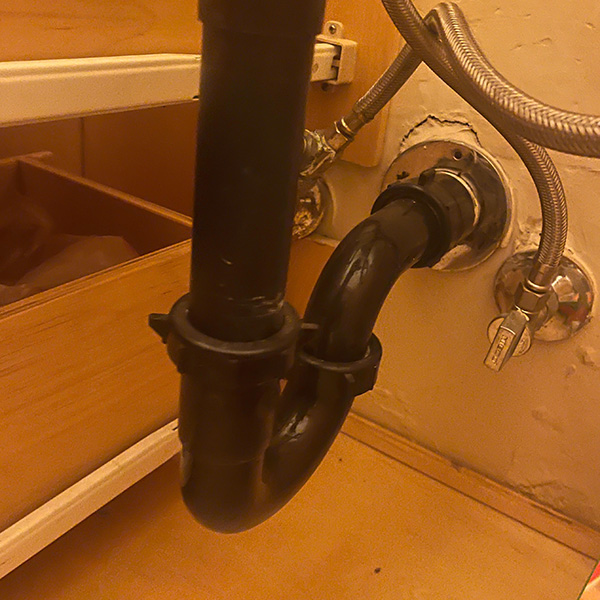
If a sink hasn’t been used in a while, the water in the p-trap can evaporate, allowing sewer gas to enter the room. This is also true for the p-trap under the shower or bathtub. If you have a bathroom that you rarely use, it’s a good idea to occasionally run water through the sink and shower to prevent smells.
Eliminating bad smells is usually pretty simple. If the smell is due to evaporation, simply pour water down the drain until the smell clears. If this doesn’t fix the problem, you may need to remove the sink stopper and pull out the trapped hair. If removing the hair doesn’t clear the problem in sinks, showers, or bathtubs, you’ll need to call a plumber.
Kitchen sink problems
Kitchen sink drains are prone to grease buildups. Rather than put cooking grease down your kitchen sink, put it in a container and dispose of it in your trash. However, grease will still accumulate in your sink from normal dishwashing.
Many kitchen sink clogs arise from placing too much waste in the garbage disposal too quickly. As we’ve discussed, avoid disposing of bulky items like potato peels, rinds, vegetable peelings and coffee grounds in the garbage disposal. Run plenty of cold water as you run the disposal.
Sewer backups
Sewer backups arise from a variety of problems. Backups usually occur at the transition outside the house between the interior sewer piping and the yard piping or from the exterior piping to the city sewer connection.
If a toilet clogs, very often the plumber can clear it with a plunger or a toilet auger. Sometimes, the plumber must pull the toilet to clear the clog or to access the sewer line. Your best bet is to install exterior cleanouts on your sewer line if you have not already installed them. This allows the plumber better access to insert drain cleaning equipment.
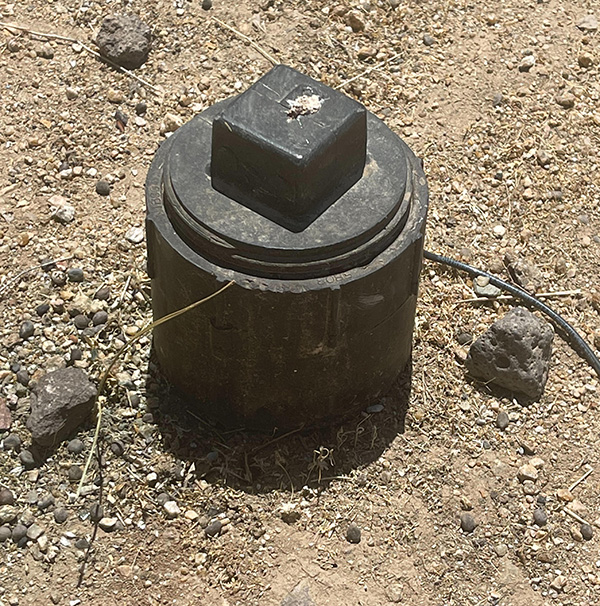
A sewer cleanout allows a plumber to easily access the pipes that connect your home to the sewer system. It can be white or black
Without cleanouts, the plumber may have to pull the toilet or walk on your roof to clean the drain. For a variety of reasons, it’s never a good idea to clean a drain from the roof. It’s a last resort.
Washing machine drains
Washing machine drains can back up and cause water damage. Many older homes have undersized washing machine standpipe drains that will not accommodate the rapid water discharge newer washing machines release.
If this is the problem, the plumber will need to change the standpipe in the wall from an inch-and-a-half to two-inch pipe.
Another problem can occur if debris clogs your washing machine’s drain line. Lint or hair buildup may cause the problem, and a plumber can clear the drain with a drain cleaning machine.
Washing machine drains usually have a clean out, but it may be behind the wall. An experienced plumber can help resolve almost any issue with your washing machine drain.
What kind of sewer system does my home have?
If you’re connected to a city sewer system and not on a septic tank, you’ll need to know what type of wastewater piping system you have. The drainage system removes wastewater from your home. Unlike your drinking water systems, which are under a great deal of pressure so that water moves readily throughout your home, your sewage system drains by gravity to flow out of your home and into the city sewer system or your septic tank.
If sewage blocks the lines that flow to the septic or city sewer main, sewage can back up into your home through sinks, showers, or toilets. There are several types of pipes used in Arizona construction. Here are the sewer pipe types we routinely find in the Phoenix metropolitan area.
Orangeburg piping – Many older homes constructed in the 40’s thru the early 70’s used Orangeburg exterior piping for their sewer system piping outside to connect from the home to the city sewer. Orangeburg pipe often disintegrates and collapses, and tree roots seeking moisture easily penetrate the piping. If your sewer line is Orangeburg, the best thing to do is replace it. It is not repairable. Orangeburg pipe is widespread in the Phoenix area.
Cast iron – Cast iron is used mainly inside the home for both drain and sewer piping. Cast iron has a roughly 50-year life expectancy. Older homes often have cast iron pipes, and many homes in Phase I and Phase II in Sun City have cast iron. Many homes built before 1972 have cast iron pipes. If cast iron fails, you have two repair options.
- Saw cut the floor, remove the old pipe and replace it with ABS or PVC pipe.
- Reline your cast iron piping, an attractive option for many because there is no need to tear up your current flooring. Relining warranties run about 25 years.
Polyvinyl chloride (PVC) – PVC is the pipe many jurisdictions favor for both sewer and drain piping. PVC has a life expectancy of about 100 years; however, your warranty will be two years for labor and the manufacturer’s warranty on the material. This means if the pipe fails in the 10th year, the manufacturer may cover the materials cost, but you’ll owe the cost for the labor. This rarely occurs, however.
Acrylonitrile butadiene styrene (ABS) – ABS pipe has been the plumbing standard for drains and sewers for the past 50 years. One drawback to ABS is that sunlight deteriorates the pipe’s integrity. This means wherever a vent pipe penetrates your roof, you’ll need ongoing maintenance such as applying a protective coating to prevent deterioration.
When buying a home or doing a major improvement, it pays dividends to have a plumber video the sewer pipes to determine their composition and their condition.
The importance of a sewer cleanout
As mentioned above, it’s important to have an accessible ground-level sewer cleanout. It should remain visible, not covered by dirt if you landscape over it, so that you can find it in an emergency. When you experience a sewer backup, you want to resolve the problem as quickly as possible. A ground-level cleanout allows easier access.
The sewer cleanout is not the vent pipe on your roof. As we mentioned earlier, using the vent pipe should be the last resort to clean blockages.
Chapter 8: Problems with Water Lines in Homes
Several types of problems can occur with your home’s water lines.
Galvanized – Older homes built before 1970 often have galvanized water lines.
Galvanized water lines corrode and leak over time. If you have galvanized water lines in your home, the best option is to replace them.
Copper pipes – Copper water lines are usually run underneath your home’s foundation when the home was built. Copper piping has a life expectancy of about 25 years; however, it often lasts longer. Over time, copper pipe may pit or suffer pinhole leaks which can cause significant damage.
Homes with underground copper water lines also have copper lines in the walls and ceilings. When these lines leak, they can cause significant damage to walls, floors and ceilings. Copper lines are easier to work on if they leak because the plumber only has to cut drywall to repair the pipe. If copper piping in the floor leaks, you have two options.
- Jackhammer the floor to access the pipe or
- Reroute the leaking pipe to eliminate the leaking segment of underground pipe.\
Most people, of course, choose the second option.
Crosslinked Polyethylene (PEX) – PEX piping is the newest pipe on the market. Most new home builders now favor PEX because it is durable and easy to work with. Plumbers don’t need a torch to install PEX pipe, making it safer to work with. Additionally, this type of pipe has little resale value making it unattractive to thieves.
There are two fastening systems plumbers use with PEX, 1) crimp-ring systems and 2) expansion systems. We recommend the expansion system because the crimp-ring system has a higher failure rate than the expansion system. We often repair many water leaks because the previous plumber used the crimp system, especially at pipe connections.
Polybutylene Piping – Known as poly pipe or PB piping, polybutylene is an outdated plumbing system that is prone to failure from chlorinated water. Shell Oil paid out millions due to poly pipe failure. If a home has PB piping, you should replace it immediately. It is common in manufactured homes and homes built in the early 80s.
Chlorinated Polyvinyl Chloride (CPVC) – CPVC pipe was the “answer” to the failures of PB pipe. Manufacturers of PB pipe replaced many home water systems with CPVC piping from the early 80s to about 2000. CPVC pipe becomes brittle with age and is prone to shatter when plumbers or homeowners attempt to work on it. In homes with CPVC or PB piping, you should strongly consider re-piping the water lines.
Chapter 9: General Plumbing Problems
Problem 1: Water hammer
Do you ever hear a “hammering” or banging sound when turning off a faucet or shower? Called water hammer, this usually occurs when a water valve or faucet is shut off quickly. There are several potential causes of water hammer and several cures.
Common causes of water hammer
- A malfunctioning pressure vacuum breaker on your irrigation system can cause water hammer.
- A pipe strap or anchor may have broken inside a wall. This will cause the pipe to vibrate when you shut off your water.
- Some plumbing fixtures may not be shutting off entirely. Usually it’s a toilet, but faulty irrigation system valves can also cause water hammer.
- You may have a loose washer or faulty seal on a faucet or toilet, causing a vibration when you quickly turn off the water.
- Your water pressure is too high.
Solutions to water hammer
While these are not all of the solutions available to remedy this common problem, these are the easiest, cheapest and most practical solutions. If these solutions don’t work, it’s time to look for professional help. Plumbers can take the following steps to cure water hammer.
- Install a water pressure regulator. If your water pressure is above 80 pounds PSI, plumbing code requires a pressure regulator. Sixty pounds PSI is an ideal pressure although in many areas acceptable working pressure is as low as 30 pounds PSI. High water pressure is a mortal enemy of plumbing fixtures such as water heaters, dishwashers and shower valves. Lower water pressure will extend the lives of these fixtures. We usually use Watts water pressure regulators. They are economical and repair parts are readily available.
- Install a water hammer arrester or a mini-hammer-arrester. We place those under a faucet or valve; some we must mount behind the wall.
- Search for and repair that leaking toilet fill valve or loose washer. While this may sound easy, that’s not always the case.
A plumber can help solve water hammer by locating and resolving the problem.
Problem 2: Faucet repairs
It’s tempting for homeowners to buy a faucet and then call a handyperson to install it. If there’s a problem with the faucet once it’s installed, the homeowner will likely have to pay a plumber to remove the problem faucet and install a replacement faucet.
Plumbers warranty their labor and the parts they provide; they don’t warranty customer-supplied parts. Faucets from a plumbing supply house are usually much better quality than those sold at big box stores.
When attempting to repair your faucet, you must first identify the faucet manufacturer. Then you must call the manufacturer to order the right parts. Often customers end up with the wrong parts and have to call us anyway. Often, cheap faucets have no identifying manufacturing marks, so homeowners are stuck with something ordered off the internet they can’t necessarily return for a refund or find replacement parts.
Problem 3: Shower cartridge and valve body repairs
A shower cartridge regulates the flow of water to the shower head. It is located in the wall. A valve body is a brass fixture behind your shower wall that mixes hot and cold water to the desired temperature.
A homeowner may need to know the manufacturer of the shower cartridge. To do this, you have to pull the trim around the shower control. An experienced plumber can usually identify the manufacturer without removing the trim.
Depending on access to the valve body, the plumber must sometimes cut the tile or drywall behind the shower to reach the valve body.
After the repair, tile or drywall may need replacement.
Problem 4: Pressure regulator valves
Plumbing code requires a pressure regulator valve on homes that have water pressure exceeding 80 pounds PSI. The pressure regulator lowers the water pressure to an acceptable standard. Experts consider 60 pounds PSI of pressure ideal.
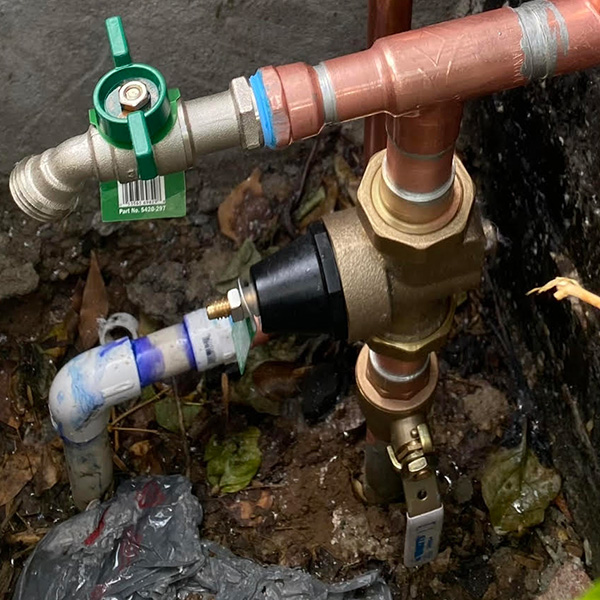
Problem 5: Pressure vacuum breakers
Pressure vacuum breakers prevent backflow of water, usually irrigation but also swimming pool water, ponds, etc., back into your home. These parts are very vulnerable to freezing temperatures. They are located just after your home’s shutoff valve, usually on a line with a tee from the main water line.
If a pressure vacuum breaker begins to leak, call a plumber because it’s a life-safety issue. While it may be okay for pets and wildlife, you don’t want to drink pool or pond water.
Mobile home plumbing problems
Most plumbers won’t work on manufactured and mobile homes for the simple reason that they just don’t want to crawl underneath. Either the plumber is too big to fit underneath the home, or they are concerned about pests and sewage. It’s critical that the underside of a mobile home be clean, relatively dry and pest-free if there is a plumbing issue. If we find areas of concern like spiders or rats, we’ll return after an exterminator has eliminated the pests, or when the area dries up.
What else do you need to know about mobile home plumbing? First, some of the fixtures and pipes aren’t traditional. They may adopt nonstandard dimensions, have hard-to-find fittings or simply have exceeded their useful life expectancy. Especially with old, galvanized hardware, some plumbers have a hard time finding replacements.
Fixing mobile home plumbing can be tricky. Choose a mobile home plumber with care.
The hazards of mobile home plumbing
What are the hazards of mobile home plumbing? Because of the significantly different nature of plumbing in manufactured and mobile homes, plumbers unfamiliar with mobile home plumbing can sometimes cause serious problems. Some of the biggest issues to consider include the following.
- Because manufactured and mobile homes use different systems for washing machine and sewer drainage, they may prove harder to drain or clean out than traditional homes, again necessitating a plumber with direct mobile/manufactured home experience.
- Because mobile homes are small, they may prove too cramped for some piping systems. That means plumbers need to be “creative” to best service the home.
- Different piping materials make it hard for some plumbers to get the right replacements, and with the wrong materials, problems become much more likely.
- Many mobile homes use plastic pipes that aren’t up to code, break easily and do not mesh well with the mobile home’s systems. You need a plumber who knows how to service, repair and replace them.
- Mobile and manufactured homes may vent drainpipes differently. To those unfamiliar with this kind of system, repair and replacement pose serious challenges and increase the chances of doing something wrong.
- Plastic piping can spring leaks much more easily than metal or CPVC or PEX tubing, very quickly making repairs outdated.
- Unusual pipe locations, meaning the structure of the entire plumbing system is uncommon. This makes replacement and repair difficult for plumbers who are not used to that type of layout. (This is one example where experience matters in plumbing.)
Chapter 10: Slab Leaks
Slab leaks can become a nightmare for a home’s plumbing as well as the home’s foundation and structure. Knowing how to spot the signs of a slab leak can help you take immediate action to protect your home and plumbing system.
A leak in the plumbing lines that run under your home may not be something you will see or notice immediately, which is why knowing what to look for is so important. Left unchecked, a slab leak could damage your home’s foundation and create a number of problems that can lead to overwhelming repair costs and a whole lot of hassle. Learning to spot the signs of a slab leak and understanding the repair and restoration process of this issue can help to protect your home and ensure your plumbing stays in optimal condition.
Keep reading to discover important information about slab leaks, your home’s foundation, and what you can expect from professional repair.
What Is a slab leak?
Your home has copper water lines that run underneath the foundation. Over time, leaks can develop in these lines, leading to a variety of problems for your foundation, home and yard. Slab leaks can happen anywhere under a home’s foundation. If pipes are present, then leaks are possible.
Slab leaks can occur on both the drainage side and the incoming pressure side of your plumbing. Left unattended, a slab leak can cause your foundation to shift, sag, or even collapse entirely. Because of the extensive damage they can cause, slab leaks require early detection and speedy repairs.
What are the signs your home may have a slab leak?
Wondering what to look for when it comes to a slab leak issue? If you notice any of the following common warning signs, it’s a good idea to call a plumber to diagnose the problem and complete repairs before damage occurs to your home.
- A soggy, wet yard – Standing water in your yard or even a wet yard when it has not rained means that water is coming from somewhere and requires investigation.
- Low water pressure – A drop in water pressure could signal a leak in the pipes under your home.
- Mildew or a musty smell – Moisture, mildew, or a musty smell you can’t track down could point to a slab leak issue.
- Soaring water bills – That leaking water is going somewhere, and if nothing in the house is overflowing or dripping, then a slab leak could be to blame.
- The sound of running water – If you are not using the washer, dishwasher, or shower but still hear running water, you could have a leak. Additionally, if your water meter dial is moving, but you are not running water, then you may have a slab leak.
What to expect from a slab leak repair
Diagnosing and repairing a slab leak is not a do-it-yourself project. These are tasks that require both specialty tools and plumbing expertise. If you have a slab leak, you need a plumbing professional who will use a variety of time-tested, proven methods to reach the leaking pipes safely and take the necessary steps to replace them.
Cutting into your home’s foundation to access the leaking pipe is not the best approach and can lead to further damage. A plumbing professional will use specialized, high-tech tools to assess the leak and precisely locate it, so he or she can target the problem effectively without damaging the rest of the home or plumbing system. Once the technician has identified the problem, he or she can remove and replace the pipe.
You may encounter a waiting period of several days from detection to completed repair for a slab leak. The plumber performing the repair should be able to provide you with an estimate and the project’s timeframe prior to beginning work. If there is damage to your home’s floors, the plumber may require additional time to make those concrete repairs.
Will my homeowner’s insurance pay for a slab leak repair?
Insurers and policies vary, but if your plumber has detected a slab leak, you should file a claim to see if your insurer will cover the costs of repair. In most cases, insurance covers the resulting damage from the leak, because the damage impacts your home, which can lead to the need for even more home repair or mold issues.
- If your insurer denies your claim and you don’t agree with that decision, call your agent and ask your agent to advocate.
- If you disagree with your insurer’s estimate of damages and cost to repair, review the appraisal clause on your policy and obtain your own estimate.
The insurance industry, like many other industries, is experiencing a big talent crunch. Today’s overworked adjusters don’t always have the extensive training adjusters received in the past. They can make mistakes. When all else fails, if you don’t agree with the coverage decision, you can file a complaint with your state’s department of insurance. It’s usually a simple process. Once the department of insurance steps in, the insurer will revisit its coverage decision. They may not change their position, but at least you tried.
Chapter 11: Conclusion: The Importance of Choosing the Right Plumber for the Job
Searching for a trustworthy plumber? The struggle is real. This decision is harder when you have thousands of plumbers to choose from. Phoenix residents know how tough it is. Yelp has over 1,300 plumbers listed for the Phoenix area. When you include the surrounding cities and suburbs, the number soars. So how can you tell which plumbers will treat you right?
Find a licensed plumber
Not all who call themselves plumbers have a license for the job. Some states do not require licenses. To acquire an Arizona plumbing license, a person must pass a trade exam and a business management examination. Passing these two tests suggests the person knows how to fix plumbing problems and how to run their plumbing business with integrity.
Choose a plumber with insurance
Part of that integrity we just talked about involves insurance. Lots of things could go wrong during your plumbing job. Insurance is protection against financial loss. A plumber’s insurance policy will protect both of you if the plumber gets hurt while working at your house, or causes damage to your home.
Bonded and insured plumbers demonstrate their commitment to fulfilling their duties on your job site. We cannot overstate how vital insurance and bonding are when selecting your plumber.
Check on your choice with your local registrar of contractors (ROC)
Determine if your plumber is a registered contractor. This offers a layer of protection, because if something goes wrong, the ROC can step in and help resolve any issues.
In most states, you can find the history of complaints filed against the contractor, as well. Arizona registered contractors must post their license number on any advertising they do, so if you don’t see an ROC number, odds are good you’re dealing with an unlicensed contractor. There are some exceptions if the ad contains a website where the license number is “prominently displayed on the website.”
Virtually any licensed contractor will occasionally have a complaint. It’s how the contractor responds to those complaints that matters. The Arizona ROC website will show a resolution of any complaints but will usually provide few details.
The Arizona ROC warns that even if a contractor displays a license number, “Always check the license before hiring a contractor by visiting the Agency’s website at www.roc.az.gov or calling the Agency during normal business hours at 877.692.9762.”
Request a detailed estimate
When you have whittled the field down to a handful of plumbers, ask one or two for estimates. Pay close attention to the level of detail in the estimates. The vaguer the estimate, the easier it will be to tack on additional charges later. Also, beware of estimates that are substantially lower than the rest. A bargain basement estimate could indicate the plumber intends to cut corners or jack up the price later.
Request references
The internet makes it easy for consumers to learn about all kinds of service providers. Read online reviews on Yelp, Facebook, the Better Business Bureau and Google. These sites can be a great place to start your research. But take one or two negative reviews with a grain of salt. Some people love to complain. Many people are more likely to share their negative experiences than their praise.
Request references. Most plumbers will give you written reviews from happy customers. Some may provide you with contact information for past clients. Contact those past customers if that makes you more comfortable.
Prepare a brief list of specific questions for those past clients before calling them. Here are a few suggestions:
- What work did you have done?
- Was the project completed on time?
- How accurate was the initial estimate?
- Did they clean up after they completed the work?
- How well did the company communicate with you?
- Would you hire this company again? Why/why not?
Research each plumber’s professional experience
On the surface, a plumber with decades of knowledge seems like a better choice than a new plumber. But the selection process is more complicated than that. Make sure your plumber has completed jobs like yours before. Ask if he or she is using the most modern methods and technology to resolve your plumbing problem. Plumbers who stay current on their training and certifications should count for a lot.
Consider how much experience a plumber has working in your geographic area. Each region has its own unique plumbing issues. A local plumber will be familiar with your location’s water quality, which can affect your plumbing system. He or she will know what common problems residents face in your neighborhood. With that knowledge, tackling your plumbing problems will be that much easier.
While the business owner may have years of plumbing experience, their plumbers may have only a year or two, or less, before they’re put on a truck and sent on service calls.
Why plumbers often charge an evaluation fee
Today’s plumbers are busy. It costs an estimated $200 to roll a truck to provide a free estimate, including the plumber’s time. Most reputable plumbers today charge an evaluation fee to provide the estimate, then provide the quote.
Believe us when we say this: “There are no free lunches.” Any plumber who offers a free estimate is going to charge more to make up for his or her time and travel expenses. Evaluation fees range from $69 to $129 and more for emergency service.
While you may have great luck finding a plumber who provides free estimates, believe us, they’re building that missing evaluation fee into their pricing.
On bigger jobs such as a full bathroom remodel, you may have better luck getting free estimates. Don’t expect them for smaller jobs, however, or understand that a free estimate won’t save you money overall.
Choosing the right Phoenix-area plumber
Phoenix presents unique challenges for service providers of all types. One obvious obstacle is the life-threatening summer heat. Another is the array of stinging and biting creatures that can also be life-threatening. There is also the small matter of caliche. It’s nature’s concrete, and it’s under every house in the Phoenix area. Caliche can make digging pipe paths almost impossible.
These are a few reasons why finding a reliable and experienced Phoenix plumber is so important. You need a plumber who has been here a long time. These are the ones who have seen and done it all. They know which areas have what type of water and sewer lines installed, know the challenges of aging homes and can help when a remodel goes wrong.
They know how to handle any plumbing problem thrown their way. You don’t have time to help a new plumber figure things out as she or he goes.
Does this mean I should NEVER hire a handyperson to fix my plumbing?
Arizona state law requires a licensed contractor perform any type of repair that costs more than $1,000, including materials and labor. If the work requires a building permit, a licensed contractor must perform the work, although the homeowner can pull the permit him or herself. Any gas job, such as running a gas line to your gas barbeque, requires a licensed contractor.
The state passed this law to protect you. If you hire a handyperson, the odds are high that he or she is unlicensed, unbonded and uninsured.
Some professional handypersons buy insurance. For a small drywall repair, painting a room, or perhaps even a toilet rebuild, a handyperson may be a good alternative. Bear in mind, however, if something goes wrong, you may have no recourse but small claims court. If you spend over $1,000, what that handyperson is doing is contracting without a license. He or she may face a fine and even jail time if you report that person to the ROC.
What do I do if I have problems with my plumbing repair?
The first thing we recommend is you pick up the phone and call the plumbing company that did the job. The dispatcher will usually politely schedule a “call-back” where the plumber who completed the work and who is most familiar with your project, returns to resolve the issue. If the dispatcher doesn’t immediately schedule the visit, he or she may transfer you to a manager to discuss the problem.
One recommendation we’d like to give is this: Never allow your frustration to overwhelm you. Any plumbing project or repair can occasionally go wrong. It’s how the contractor responds to your problem that separates one plumber from the stellar professional service firm.
In the past we have sometimes seen that, in frustration, the homeowner will post a negative review without first giving the plumber a chance to respond to the problem. The first notice that there is a problem is a very public bad review. If the plumber doesn’t know there’s a repair problem, he or she can’t respond.
We suggest calling the plumbing company first before posting a negative review. Most people dislike what we perceive as “confrontation.” A failed plumbing repair should never be a confrontation, it should be an exploration between the homeowner and the company to learn what went wrong and to make it right.
When reading reviews, if you read a negative Google or Yelp review on a company, read the contractor’s response. See how that company responds to any complaints. Everyone makes mistakes from time to time, and sometimes a repair can cause other issues to arise. Very often, what customers think is a callback doesn’t arise from the original work, it’s a different problem. For example, a hose bib repair goes fine, but the sprinkler valve suddenly decides to flood the yard, unrelated to the plumbing repair.
Trusted contractors will work hard to resolve your concerns or complaints. Call before you post that negative review.
Some final thoughts on plumbing
We were chatting with a friend of ours about some of the challenges of business ownership. She’s owned an antique store in northern Arizona for over 30 years. “People are always happy when they’re in my store,” she said, “And if they buy something, it’s something they’ll look at and treasure for years. I rarely have an unhappy customer.”
It’s different with plumbing, we told her. Most of what we repair is behind the walls or is a necessity, like a toilet rebuild. We rarely run into customers enthusiastic about spending money on plumbing. Often, they call a plumber only after something bad happens, like a water leak that damages their home. To add insult to injury, plumbing repairs can be costly.
Plumbing is the guts of your home. Your home’s plumbing infrastructure is vital to your health.
Plumbers spend years learning and honing their trade. When the pandemic struck, we suddenly became “essential workers,” and frankly, we’ve never seen our plumbers prouder of the critical services they provide.
We’ve been Phoenix-area plumbers for over 40 years. With our combined plumbing staff, we have well over a century of plumbing experience right here in Phoenix.
We are proud of what we do, and we love our customers. We watch as their kids grow up, as our customers age and move out of their homes and into new homes or into assisted living.
We hope this book is helpful to you. Plumbing is our livelihood, and we hope that we meet you one day.
JOIN THE SAV-ON PLUMBING VIP CLUB
You need a friend in the plumbing business
-Dedicated VIP Hotline - 24/7 priority response
-$20 gift certificate good toward your first service
-Special VIP offers on preventative service
-First notice of all promotions and special offers
